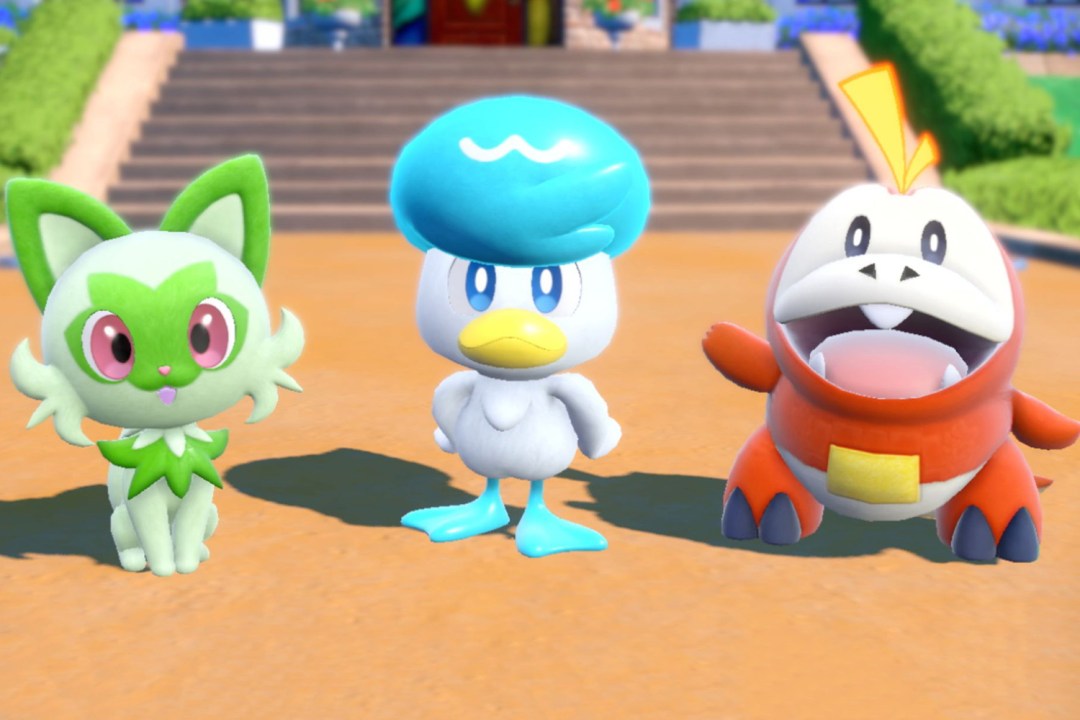Pokémon Scarlet and Violet review: dropped the pokéball?
The series at its most revolutionary, marred by presentation and performance issues

There’s hardly been a shortage of Pokémon games on the Switch, including 2021’s Diamond and Pearl remakes, as well as semi-open world spin-off Legends: Arceus earlier this year. But Pokémon Scarlet and Violet are the ones fans have been waiting for, perhaps for their entire lives.
While open world elements have been teased in limited capacities before, the mainline series’ ninth generation finally fulfils that promise. This is a true open world Pokémon experience that fans have been dreaming of since the original game debuted 26 years ago.
However, much has been made of developer Game Freak struggling to adapt the series from its handheld 2D roots to the full 3D home console experience. Previous efforts came up short presentation-wise compared to other big blockbusters, or indeed the rest of Nintendo’s first party output.
With a few Switch releases now under its belt, surely Scarlet and Violet are the ones where the studio finally nails it?
Paldea is your oyster


This latest Pokémon generation lands in two versions, just like other mainline entries, with slight differences in content. We played Scarlet for this review, but the setting and set-up is the same for both: create your character, then head out on a journey to become a Pokémon trainer in new region Paldea, which is largely inspired by Spain and the Iberian Peninsula.
Once you’re inducted into your Hogwarts-esque academy, you soon realise the familiar Pokémon structure has been completely shaken up. Yes, you’re still trying to be the best Pokémon trainer by battling the region’s gym leaders, but that’s just one of three story paths open from the outset. You can also take down a gang of bullies called Team Star, who control various bases around the region, as well as seek out Titan Pokémon. And you can do it in whatever order you wish.
To an extent, anyway. These challenges still have set levels, so attempting to take on the toughest gym leader or capturing a wild high-level Pokémon will see you getting totally stomped. Nonetheless, the game won’t stop you from trying, and there’s still so many directions you can choose to go early on. You won’t want to rush around straight away though, as you’re also in the business of capturing Pokémon to then train as part of your party, and they’re everywhere. Walk around and you’ll find all kinds of varieties popping up: between the two games, there’s over 400 to catch for your Pokédex, with over 100 of these being brand new.
One of the most important new Pokémon, besides the traditional choice of three starter ‘mon, is a Legendary one – the kind you’d normally only encounter during the endgame. Here they’re not actually used for battling, but as a very helpful mount for traversing the world faster. New abilities like swimming, rock climbing, and gliding unlock as you progress, becoming crucial for reaching other areas.
Ready to battle


There’s still one area where Scarlet and Violet cling to tradition. The turn-based battles when encountering other Pokémon or trainers still uses the accessible rock-paper-scissors format where you must figure out which of your Pokémon’s attacks are effective against your rival. The depth comes from discovering, earning, or even crafting new moves (TMs, short for Technical Machines) that you can teach them.
Arceus fans may lament that you can’t simply catch Pokémon by lobbing a PokéBall at them unawares here, but that game was arguably a more action-oriented spin-off. A host of other improvements still streamline the experience, like being able to send out your lead Pokémon to auto-battle lower-level Pokémon in the wild to alleviate some of the grind – though you’ll still need to fight and weaken a new Pokémon if you want to catch them. Most welcoming is how rival trainers now only initiate a battle when you walk up and talk to them, so you’re no longer forced into a tight route where locking eyes with someone instantly means a fight.
Also unique to Scarlet and Violet is briefly buffing your Pokémon through the rather bizarre Terastalization mechanic. Using a crystal orb temporarily turns your Pokémon into a bigger crystallised version, which while looking odd at first also makes for a visual trip. You’ll need to recharge the orb between uses, so you can’t just spam it, but opponents can also deploy it against you.
Giant crystals randomly placed throughout the world give the chance to battle and capture wild terastalized Pokémon in Tera Raid Battles, which can be done in online co-op or alone (the latter just matches you with three other AI-controlled trainers). It’s a great way of gaining bonus XP, as well as finding Pokémon of a different type type from ones normally found in the wild.
It’s super defective


Yet despite all the ways Scarlet and Violet should excite both new and veteran fans of the series, it’s almost impossible to ignore just how poorly these games run. It’s as if you’ve paid for an early access PC title that’s still in alpha, rather than a full-priced Nintendo game from a billion-dollar blockbuster franchise.
Even if you can overlook the bare bones environmental textures, Paldea’s regional design feels lacking in imagination the more you get out into the world. It arguably looks at its best in the initial areas, like your own house and the academy. Most of the creativity seems to have gone into the Pokémon designs (which admittedly are terrific, inspired, and goofy in equal measure) but when the open world is meant to be just as much of a character, it’s a shame to see less care put in here.
Much harder to ignore is how the game struggles to maintain a consistent frame rate, or the rampant pop-in. That’s despite the obvious number of cutbacks, like how town buildings (with the exception of gyms) don’t have interiors but just a menu for shops. Even before getting to the open world, there’s a classroom scene where students are animated at such a hilariously reduced frame rate it might have been better with no animations at all.
That’s not to say it ever gets to the point that the game is unplayable. Perhaps because battles are fought turn-based rather than in real-time it’s easier to forgive if things descend into a slideshow, although the time it takes to switch between Pokémon during a battle is harder to ignore, given you’ll be doing it a lot.
When we’ve seen visually outstanding exclusives with huge scale this year, like Xenoblade Chronicles 3 and Bayonetta 3 running in stable conditions on Switch, there’s no reason at this point why we shouldn’t expect the same quality from a franchise that dwarfs those games in popularity.
Pokémon Scarlet and Violet verdict


Compared to the other recent Pokémon titles, Scarlet and Violet are by far the most ambitious in scope, with a genuine open world that revitalises the series in the same way as – yes, we’re going there – Breath of the Wild.
Yet there’s no ignoring that this fantasy is constantly being interrupted by terrible performance issues – ones which shouldn’t be acceptable for a first-party Nintendo title, not least its biggest franchise.
As a proof of concept, this is comfortably the future of the series, and one that we’re more than excited to be at ground level for. We can only hope that the next iteration will be on more powerful hardware – and that Game Freak partners with a trusted co-developer to ensure the series’ vision also looks the part.
Stuff Says…
If you can look past the glaring performance woes, this is the most exciting and forward-thinking Pokémon generation in years.
Good Stuff
A truly open world Pokémon game
Three interesting and varied story paths
Excellent new Pokémon designs including Legendaries
Bad Stuff
Underwhelming presentation
Runs terribly



